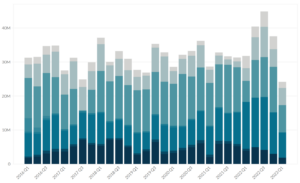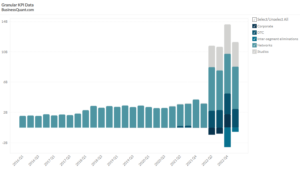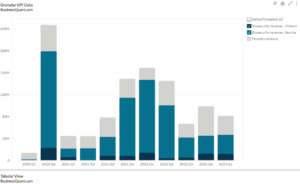
Seagate’s HDD Revenue (2016-2023)
Exclusive Data
You need the Pro Plan to access KPI data
- Full access to the platform
- KPI data & segment financials on US stocks
- Financial data on thousands of stocks
- Download data in xlsx and csv formats
Pro Plan
$49 per month*
60% discount ends in:
.
About
More information
Subscribe to Pro or Enterprise plans to unlock this feature.
Contact the Analyst
Subscribe to Pro or Enterprise plans to unlock this feature.
Become a smarter investor today.
Access KPIs & Segment Financials on US stocks
This statistic highlights Seagate’s HDD Revenue, reported on a quarterly basis from Q1 2016 onwards.
Seagate Technology engages in electronic data storage technologies and solutions, founded by Finis Conner, David Thomas Mitchell, Alan F. Shugart, Syed Iftikar, and Doug Mahon in 1979 and is headquartered in Dublin, Ireland. Seagate’s first development was a 5.25-inch hard drive of 5 megabytes in 1980. Its products and services include internal hard drives, network-attached storage, high-performance computing, data protection appliances, backup and recovery services, and related solutions.
Seagate’s HDD product mix merely includes enterprise & cloud division; edge non-compute segment consists of the sale of in-device memory products and edge computing segment, which includes drives for desktops and notebooks.
The year 2016
Worldwide storage hardware market has witnessed a slowdown over the last few years due to a drop in prices and particularly low demand in the consumer market for laptops and desktop computers. Seagate also reported a fall in hard drive prices, leading to revenue declines over the last two years. Seagate’s HDD revenues through the first three quarters of 2016 have fallen by 21% year-over-year to around $7.7 billion. The reason is attributable to low unit shipments this year across product lines along with combined hard drive units shipped for the Compute segment was down by 20% YoY to 48.7 million units.
The year 2017
In Q1, the company reported an HDD revenue of $2.59 billion, which is slightly decreased by 4.78% YoY as all the segments witnessed a fall in sales by 15% YoY. Edge non-compute revenue remains unaffected in Q2, while other segments saw a downfall, which slightly increased the revenues to $2.65 billion. Remaining quarters just saw a linear downfall as edge compute revenue has been dropping steadily and expected to see the trend to continue in the future as demand for PCs and notebooks fails to pick up.
The year 2018
In Q2, Seagate reported YoY growth in revenue, exabyte shipments, and profitability along with strong demand in the enterprise segment. In other segments, Seagate anticipates sequential unit demand decline, which the firm has attributed to seasonality. Seagate believes that its nearline products are in the early stages of global cloud storage transformation because they were driving the revenue.
The year 2019
Total revenue has dropped from $10.39 billion in 2019 from the last two years because of lower demand and pressure on the memory market. Out of which, total HDD revenue has dropped 17% in the last quarter YoY on the back of slow demand growth. Revenue from the edge compute segment has been a significant loser, losing the HDD revenue significantly. Mainly due to the growing use of streaming services and cloud storage services, which has driven down demand for physical storage devices. However, edge non-compute revenue, which includes the sale of in-device memory products, remains unaffected.
The year 2020
Overall, HDD revenue, expected to rise as Seagate’s enterprise & cloud division is expected to contribute well to total revenue in 2020 and can make up 41% of the company’s revenue estimate. The edge non-compute segment, which mainly offers external storage devices, comes in at a close second and is expected to make up around 40% of 2020’s revenue estimate. And the remaining edge computes business, expected to make up 19% of the total revenue estimate.
Did you like Seagate’s HDD Revenue statistic? Get access to such granular datasets by registering for free.
More data on US Stocks

Our Plans
Always know what you’ll pay. No hidden costs or surprises.
- Annual
- Monthly
60% discount till April 30
Pro
For serious investing
-
Company KPI data Access segment financials, non-GAAP metrics and KPI data from presentations and filings. Examples include financials by segment / region / product category, AT&T's broadband subscriber trends, Tesla's deliveries by model and lots more.
-
Stock research tools Features include : stock screener, stock comparison, industry financials, stock warnings, advanced charting tools, timeseries tables, scatter charts, financial statements, stock reports, SEC filings, stock ratings, institutional and insider ownership data. There are 200+ financial items and ratios on thousands of US stocks.
-
Industry data & tools Access premium operating data on 40+ industries. Examples include market share, smartphone shipments by vendor, subscribers by wireless carrier, historical gold production. There are 20,000+ such statistics.
Enterprise
For tailored workflows
-
All of Pro plan Get unfettered access to all our dashboards and dossiers.
-
Custom built features Get tailored dashboards built specially for you , based on your set of requirements, to simplify your research workflow.
-
Admin billing Back-end documentation support and multi-seat licensing.
* Billed annually, local taxes extra.
60% discount on Annual plan
Pro
For serious investing
-
Company KPI data Access segment financials, non-GAAP metrics and KPI data from presentations and filings. Examples include financials by segment / region / product category, AT&T's broadband subscriber trends, Tesla's deliveries by model and lots more.
-
Stock research tools Features include : stock screener, stock comparison, industry financials, stock warnings, advanced charting tools, timeseries tables, scatter charts, financial statements, stock reports, SEC filings, stock ratings, institutional and insider ownership data. There are 200+ financial items and ratios on thousands of US stocks.
-
Industry data & tools Access premium operating data on 40+ industries. Examples include market share, smartphone shipments by vendor, subscribers by wireless carrier, historical gold production. There are 20,000+ such statistics.
Enterprise
For tailored workflows
-
All of Pro plan Get unfettered access to all our features.
-
Custom built features Get tailored dashboards built specially for you , based on your set of requirements, to simplify your research workflow.
-
Admin billing Back-end documentation support and multi-seat licensing.
* Local taxes extra.






